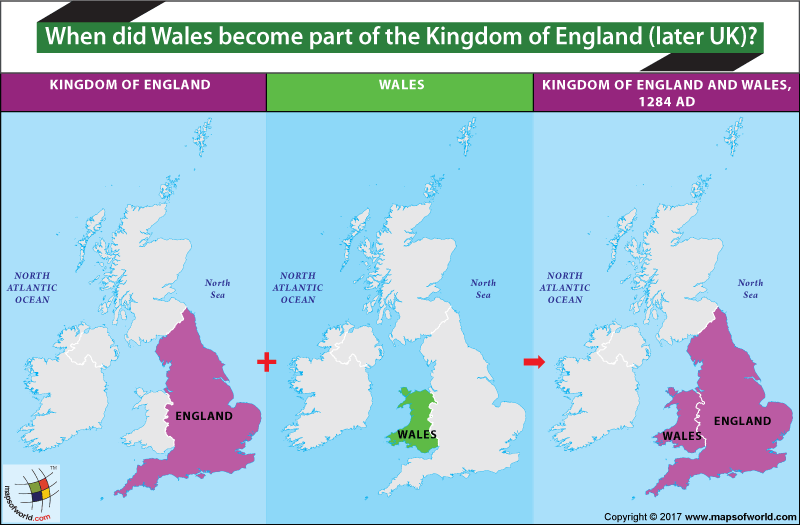When did Wales become part of the United Kingdom?

When Did Wales Become Part of England?
In 1284, with the Statute of Rhuddlan, Wales became a part of the Kingdom of England (which later came to be known as the United Kingdom, after the merger of Scotland and Ireland with England). King Edward of England annexed Wales in 1282, and legally, Wales became a part of the United Kingdom with the ‘Laws in Wales Acts,’ of 1535-1542.
Wales’ history goes back to native rule. The early Kingdom of Wales is said to have roots even older than that of England. Great Britain has evolved over the centuries from several independent countries, one of them being Wales.
The last independent years of the Principality of Wales were marked by tension. Gwynedd had been seized by Edward I, and the Welsh lords of Deheubarth were kept embroiled by English administration. Major issues in the Principality were being decided by the English law, rather than Welsh. The public opinion of the Welsh people was massively disregarded. Many were left disillusioned by this, including Dafydd who was previously the King’s ally.
It was the Palm Sunday of 1282 when Dayfydd attacked Hawarden Castle. This event sparked a revolt across Wales. Llywelyn, the Prince of Gwynedd, and eventually the de-facto ruler over most of Wales, joined the revolt several months later. In 1282, Edward I attacked Llywelyn, determined to clinch the whole of Wales. In December 1282, when Llywelyn tried to rouse his men he was killed.
Dafydd took the title of the ‘Prince of Wales,’ upon Lynwelyn’s death, and the struggle continued. In April 1283, Dafydd was captured and executed. All of Wales, except March, were now subject to the King’s authority. The Lords of March had been the King’s ally, and so were awarded new Lordships. Most of the territory that was conquered was divided into 6 counties. In 1301, The King made Edward, born at Caernarfon in 1283, his heir and handed him control of these counties, and the title of the ‘Prince of Wales.’ Since then, the eldest son of each English monarch bears this title.
The situation in Wales was such that it had neither become a part of England, nor were the Welsh people given the treatment similar to the English people in terms of the law, taxation, and land tenure. Further, the Treaty of Rhuddlan ensured that Wales continued to be divided on ethnic grounds.
In the 1300s, the resentment against the Kingdom of England was manifested in the literature of the period, and was perpetuated in the several revolts; first in 1287, then 1294, and in 1316. Beginning of the 15th century, Wales saw the revolt led by Owain Glyndŵr.
If a Welsh had a claim to the title ‘Prince of Wales,’ it was Owain Glyndŵr. He was heir to the dynasty of Powys Fadog, on his father’s side, and descended from the dynasty of Lord Rhys of Deheubarth, on is mother’s side.
Henry IV, who was the King of England then, is said to not have mediated fairly between Owain and his neighbor of Ruthin Marcher Lordship, a dispute the two were embroiled in. This prompted the revolt in September 1400, when Owain was hailed as the Prince of Wales by his supporters at Glyndyfrdwy. Owain was victorious again at Pumlumon and was hailed all across Wales. In spite of the many campaigns led against him by the King, Owain remained at large. Unable to do much, the Parliament passed the Penal Code which made the gathering of, gaining access to office, carrying arms, and settling in fortified towns of the rebellious Welsh people illegally.
In 1509, Henry VIII became the King of England. The house of Tudor ruled England, Wales, and Ireland from 1485 to 1603. Now the Crown controlled the principality of Wales along with the Lancastrian and Yorkshire lordships of the March. The powers of the lords of the March were also abolished to strengthen the sovereignty of the Crown.
The Act of Union was passed in 1536, and March was divided into seven counties: Denbigh, Montgomery, Radnor, Brecon, Monmouth, Glamorgan, and Pembroke. The principality and the March were united. Wales was to be ruled only by the English Law; justices of the peace were appointed in every county to administer it. English was to be the only language of the courts.
The final distinction between Wales and England was removed in 1830, when the Welsh court system, known as the Courts of Great Session, was abolished.
Related Links:

